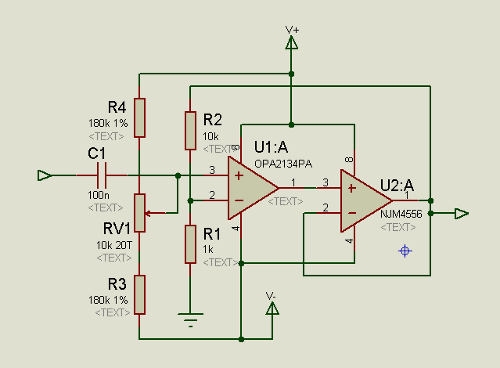backspace119
Member of the Trade
- Joined
- Feb 3, 2014
- Posts
- 67
- Likes
- 10
My opamps that I had ordered (OPA2134PA and NJM 4556AD) came recently and so I have been tampering with my CMoy again. I tried both and found that the 4556 worked much better for my purposes (low impedance headphones with a bass boost circuit implemented) the only issue was, with the bass boost all the way up, the DC offset was around 400 mV....definitely an issue...with the 2134 it wasn't an issue (offset with bass boost all the way up was 17 mV) but it couldn't handle as much current as the 4556 and thus distorted at levels that the 4556 wouldn't. I decided I would try to get the best of both and use the 4556 as a buffer. I built the circuit as per the usual CMoy except I shorted the output of the OPA to the + input of the 4556 and routed its output back to the OPAs - Input through a 2.2K resistor (gain value is ~5.7 (ground resistor is 470 and gain is 2.2k) I also shorted the 4556s output to its - input making it unity gain. I also do not use a vGnd as it could create more distortion issues. I use 2 batteries and a real ground.
When I turned it on i got an offset in both channels of about 6.9 Volts. The 9v batteries I'm using are a bit drained (measure at 7.98 Volts and 7.1 Volts) but I don't think that should cause this bad of an offset. I checked for shorts and found none and used a meter to make sure there were no shorts and all that. I looked at some previous threads about this and it would seem this circuit should work.
Whats the issue here? any ideas?
Is the 4556 not unity gain stable (checked the sheets but couldnt find anything about it being unity gain stable)
Sorry for no pics I don't have a camera
Also sorry for no schematic but I didn't have time to make one, I might try to make one tommorow to show my implementation. The main way it works is:
OPA => 0 ohms=>(+)4456 => 0 ohms=I
gnd <= 100K <= (+)(-) <= 2.2K ohms <= (-) <========I
I
V
470 ohms ====> gnd
Any help greatly appreciated and I thank you for your time in advance
EDIT: After fooling with the design it still has this issue. Here's a schematic. I am really quite lost at this point.

Please if anyone has any idea whats going wrong please help. It is spitting out 7-8V DC (seems to fluctuate some times)
When I turned it on i got an offset in both channels of about 6.9 Volts. The 9v batteries I'm using are a bit drained (measure at 7.98 Volts and 7.1 Volts) but I don't think that should cause this bad of an offset. I checked for shorts and found none and used a meter to make sure there were no shorts and all that. I looked at some previous threads about this and it would seem this circuit should work.
Whats the issue here? any ideas?
Is the 4556 not unity gain stable (checked the sheets but couldnt find anything about it being unity gain stable)
Sorry for no pics I don't have a camera

Any help greatly appreciated and I thank you for your time in advance
EDIT: After fooling with the design it still has this issue. Here's a schematic. I am really quite lost at this point.
Please if anyone has any idea whats going wrong please help. It is spitting out 7-8V DC (seems to fluctuate some times)


